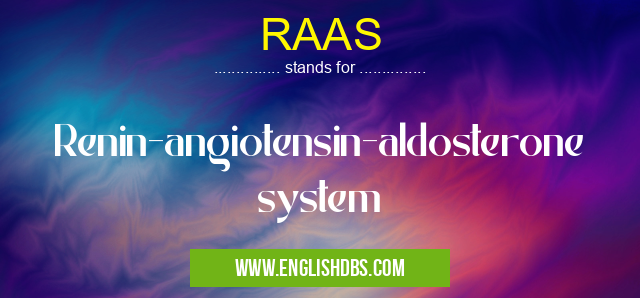What does RAAS mean in HEALTHCARE
The RAAS is regulated by a variety of factors, including:

RAAS meaning in Healthcare in Medical
RAAS mostly used in an acronym Healthcare in Category Medical that means Renin-angiotensin-aldosterone system
Shorthand: RAAS,
Full Form: Renin-angiotensin-aldosterone system
For more information of "Renin-angiotensin-aldosterone system", see the section below.
» Medical » Healthcare
Components of the RAAS
- Renin: An enzyme produced by the kidneys that converts angiotensinogen, a protein produced by the liver, into angiotensin I.
- Angiotensin I: A peptide that is converted into angiotensin II by angiotensin-converting enzyme (ACE).
- Angiotensin II: A potent vasoconstrictor that increases blood pressure by narrowing blood vessels.
- Aldosterone: A hormone produced by the adrenal glands that promotes sodium and water retention in the kidneys, increasing blood volume.
Mechanism of Action
- Activation: When blood pressure or blood volume falls, the kidneys release renin.
- Angiotensin I Formation: Renin converts angiotensinogen into angiotensin I.
- Angiotensin II Formation: Angiotensin I is converted into angiotensin II by ACE, which is found in the lungs.
- Vasoconstriction: Angiotensin II binds to receptors on blood vessel walls, causing vasoconstriction.
- Aldosterone Release: Angiotensin II stimulates the adrenal glands to release aldosterone.
- Sodium and Water Retention: Aldosterone promotes sodium and water retention in the kidneys, increasing blood volume.
Regulation of the RAAS
- Blood Pressure: Increased blood pressure inhibits renin release.
- Blood Volume: Increased blood volume also inhibits renin release.
- Sodium Intake: High sodium intake stimulates renin release.
- Angiotensin II: Angiotensin II can inhibit its own production through negative feedback.
Clinical Significance
Inhibition of the RAAS is a common therapeutic strategy for treating high blood pressure (hypertension) and heart failure. Medications that target the RAAS include:
- ACE inhibitors: Block the conversion of angiotensin I to angiotensin II.
- Angiotensin II receptor blockers (ARBs): Block the binding of angiotensin II to its receptors.
- Aldosterone antagonists: Block the effects of aldosterone.
Essential Questions and Answers on Renin-angiotensin-aldosterone system in "MEDICAL»HEALTHCARE"
What is the Renin-angiotensin-aldosterone system (RAAS)?
The RAAS is a hormonal system involved in regulating blood pressure, fluid balance, and electrolyte homeostasis. It consists of three main components: renin, angiotensin II, and aldosterone.
How does the RAAS work?
When blood pressure drops, the kidneys release renin, which converts a liver protein called angiotensinogen into angiotensin I. Angiotensin I is then converted to angiotensin II by an enzyme called angiotensin-converting enzyme (ACE). Angiotensin II causes blood vessels to constrict, raising blood pressure. It also stimulates the adrenal glands to release aldosterone, which promotes sodium reabsorption in the kidneys, leading to fluid retention and further blood pressure increase.
What is the role of RAAS in hypertension?
The RAAS plays a significant role in the development and progression of hypertension. Overactivation of the RAAS can cause excessive vasoconstriction and fluid retention, leading to elevated blood pressure.
How is RAAS inhibition used to treat hypertension?
Drugs that inhibit the RAAS, such as ACE inhibitors and angiotensin II receptor blockers (ARBs), are commonly used to treat hypertension. These medications block the actions of angiotensin I or angiotensin II, reducing blood vessel constriction and fluid retention, thereby lowering blood pressure.
What are the potential side effects of RAAS inhibitors?
Common side effects of RAAS inhibitors include low blood pressure, dizziness, and fatigue. Less common side effects may include dry cough, hyperkalemia (high potassium levels), and angioedema (swelling of the face, lips, or tongue).
When should RAAS inhibitors be avoided?
RAAS inhibitors should be avoided in people with severe kidney disease or a history of angioedema. They should also be used cautiously in people with diabetes, as they may increase the risk of hyperkalemia.
Final Words: The RAAS is a complex hormonal system that plays a vital role in maintaining blood pressure and electrolyte balance. Understanding the components, mechanism of action, and regulation of the RAAS is essential for developing effective treatments for cardiovascular disorders.
RAAS also stands for: |
|
| All stands for RAAS |
